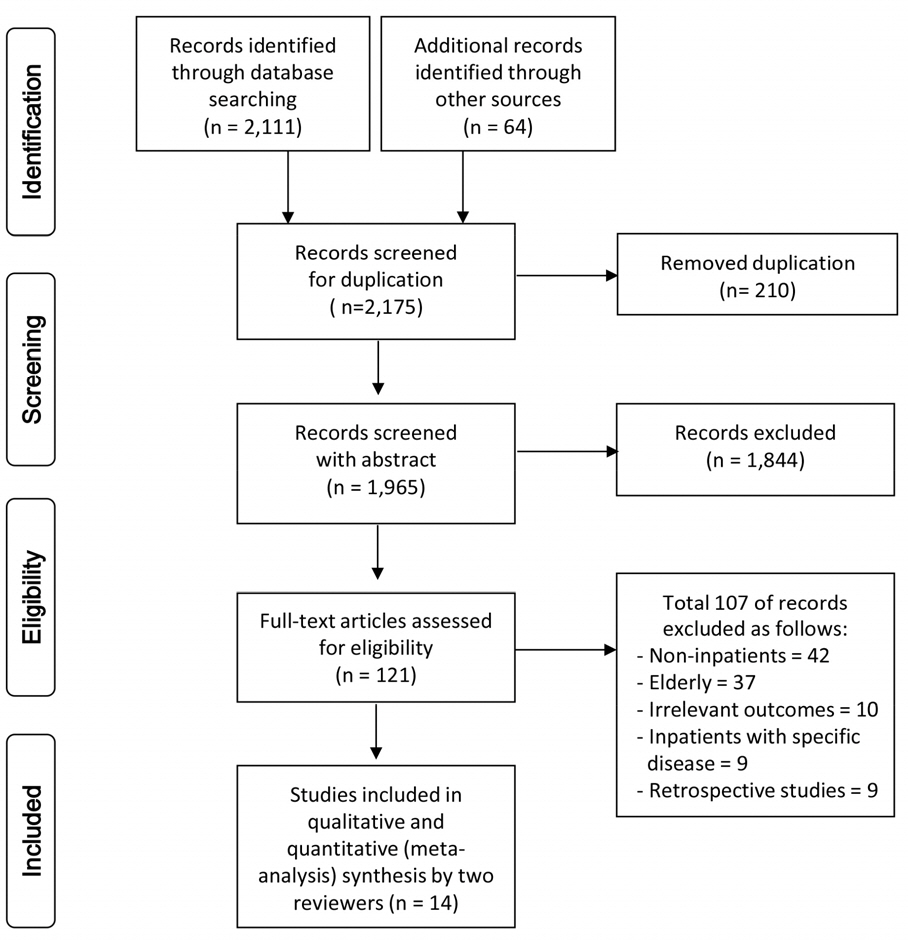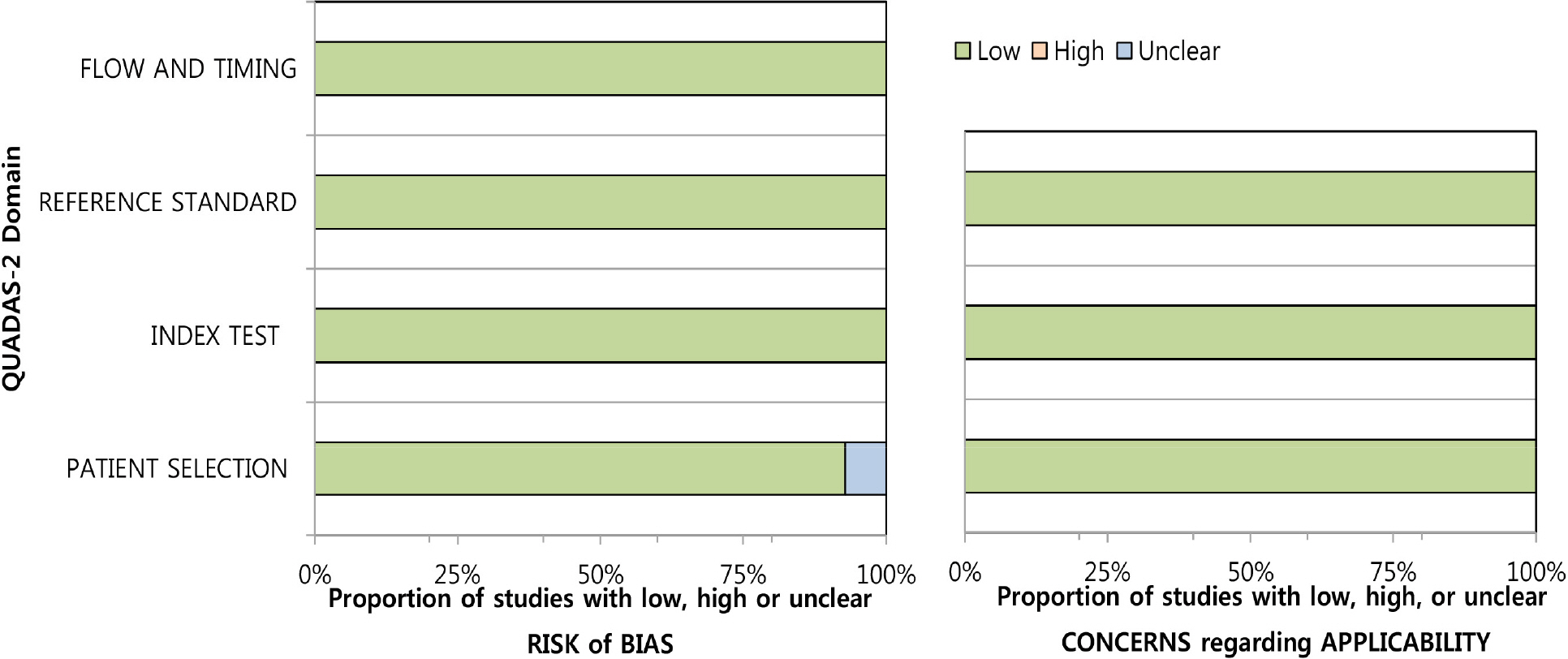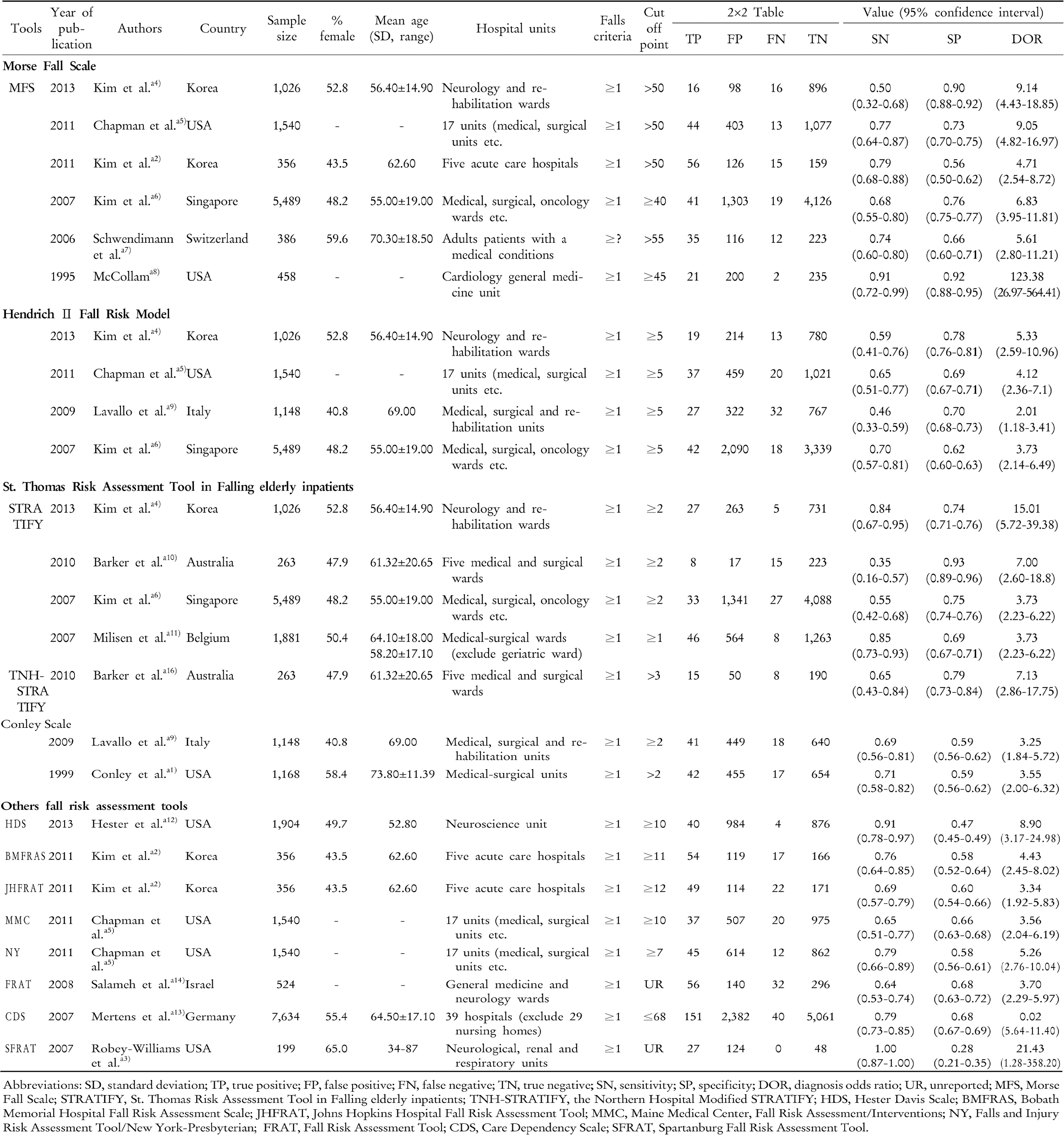| Korean J Health Promot > Volume 16(3); 2016 > Article |
|
ABSTRACT
Background
The aim of this study was to determine which fall-risk tool is most accurate for detecting and predicting adults in the hospital setting.
Methods
A literature search was performed to identify all studies published between 1946 and 2014 from periodicals indexed in Ovid Medline, Embase, CINAHL, KoreaMed, NDSL and other databases, using the following keywords: ‘fall', ‘fall risk assessment', ‘fall screening', ‘mobility scale', and ‘risk assessment tool'. The QUADAS-2 was applied to assess the internal validity of the diagnostic studies. Fourteen studies were analyzed using meta-analysis with MetaDisc 1.4.
Results
The result of comparing twelve tools was that the Morse Fall Scale (MFS) is the best tool for predicting falls for acute hospitalized adult patients. Six prospective validation studies using MFS with high methodological quality, involving 9,255 patients, were included. Meta-analysis finding of MFS was as follows; pooled sensitivity 0.73 (95% confidence interval [CI]: 0.68–0.78), pooled specificity 0.75 (95% CI: 0.74–0.76), area under the curve (AUC) of summary receiver operating characteristics (sROC) curve 0.79 (standard error [SE] = 0.02), and value of index Q∗ 0.72 (SE = 0.01) respectively.
References
1. World Health Organization. WHO global report on falls prevention in older age. Geneva: WHO Press; 2008.
2. Morse J. Enhancing the safety of hospitalization by reducing patient falls. Am Infect Control 2002;30(6):376-80.

3. Perrell KL, Nelson A, Goldman RL, Luther SL, Prieto-Lewis N, Rubenstein LZ. Fall risk assessment measures: an analytic review. J Gerontol A Biol Sci 2001;56(12):M761-6.

4. DiBardino D, Cohen ER, Didwania A. Meta-analysis: multidisciplinary fall prevention strategies in the acute care inpatient population. J Hosp Med 2012;7(6):497-503.



5. Hitcho EB, Krauss MJ, Birge S, Claiborne Dunagan W, Fischer I, Johnson S, et al. Characteristics and circumstances of falls in a hospital setting. J Gen Intern Med 2004;19(7):732-9.



6. Ledford L. Research-based protocol: prevention of falls. Iowa City: University of Iowa Gerontological Nursing Intervention Research Center; 1997.
7. Stalenhoef PA, Diederiks JP, Knottnerus JA, Kester AD, Crebolder HF. A risk model for the prediction of recurrent falls in community-dwelling elderly: a prospective cohort study. J Clinl Epidemiol 2002;55(11):1088-94.
8. The Victorian Quality Council. Minimizing the risk of falls & fall-related injuries: Guidelines for acute, subacute and residental care setting [Internet]. Melbourn Victoria: The Metropolitan Health and Aged Care Services Division Victorian Government Department of Human Services; 2004. [Accessed March 10, 2015].. http://www.health.vic.gov.au/qualitycoun-cil/downloads/falls/research.pdf.
9. Morse JM. Computerized evaluation of a scale to identify the fall-prone patient. Can J Public Health 1986;77(Suppl 1):21-5.

10. Schmid NA. Reducing patient falls: A research-based comprehensive fall prevention program. Mil Med 1990;155(5):202-7.

11. Hendrich A, Nyhuuis A, Kippenbrock T, Soga ME. Hospital falls: Development of a predictive model for clinical practice. Appl Nurs Res 1995;8(3):129-39.


12. Oliver D, Britton M, Seed P, Martin FC, Hopper AH. Development and evaluation of an evidence based risk assessment tool (STRATIFY) to predict which elderly inpatients will fall: case-control and cohort studies. BMJ 1997;315(7115):1049-53.



13. Poe SS, Cvach M, Dawson BP, Straus H, Hill EE. The Johns Hopkins fall risk assessment tool: Postimplementation evaluation. J Nurs Care Qual 2007;22(4):293-8.

14. Korea Hospital Nurses Association. Safety management guidelines for nursing. 6th ed.. Seoul: Hospital Nurses Association; 2005.
15. Korean Statistical Information Service. Condition of annual medical expenses per person by ages at inpatient [Internet]. Deajeon: Korean Statistical Information Service; 2015. [Accessed January 20, 2016].. http://kosis.kr/statHtml/stat-Html.do?orgId=350&tblId=DT_35001_A050&conn_path=I2.
16. Matarese M, Ivziku D, Barttolozzi F, Piredda M, De Marinis MG. Systematic review of fall risk screening tools for older patients in acute hospitals. J Adv Nurs 2015;71(6):1198-209.



17. Aranda-Gallardo M.. Morales-Asencio JM, Canca-Sanchez JC, Barrero-Sojo S, Perez-Jimenez C, Morales-Fernandez A, et al. Instruments for assessing the risk of falls in acute hospitalized patients: a systematic review and metaanalysis. BMC Health Serv Res 2013;13:122.


18. Billington J, Fahey T, Galvin R. Diagnostic accuracy of the STRATIFY clinical prediction rule for falls: a systematic review and metaanalysis. BMC Fam Pract 2012;7(13):76.




19. Harrington L, Luquire R, Vish N, Winter M, Wilder C, Houser B, et al. Meta-analysis of fall-risk tools in hospitalized adults. J Nurs Adm 2010;40(11):483-8.


20. Muir SW, Berg K, Chesworth B, Klar N, Speechley M. Quantifying the magnitude of risk for balance impairment on falls in community-dwelling older adults: a systematic review and metaanalysis. J Clin Epidemiol 2010;63(4):389-406.


21. Deeks JJ, Bossuyt PM, Gatsonis C. Cochrane handbook for systematic reviews of diagnostic test accuracy version 1.0 [Internet]. London: The Cochrane Collaboration; 2010. [Accessed May 30, 2013].. http://srdta.cochrane.org/.
22. Moher D, Liberati A, Tetzlaff J, Altman DG. PRISMA Group. Preferred reporting items for systematic reviews and metaanalyses: The PRISMA statement. Ann Intern Med 2009;151(4):264-9.


23. Whiting PF, Rutjes AW, Westwood ME, Mallett S, Deeks JJ, Reitsma JB, et al. QUADAS-2: A revised tool for the quality assessment of diagnostic accuracy studies. Ann Intern Med 2011;155(8):529-36.


24. Zamora J, Abraira V, Muriel A, Khan KS, Coomarasamy A. Meta-DiSc: a software for metaanalysis of test accuracy data. BMC Med Res Methodol 2006;6:31.




25. Greiner M, Pfeiffer D, Smith RD. Principles and practical application of the receiver-operating characteristic analysis for diagnostic tests. Prev Vet Med 2000;45(1–2):23-41.


26. Walter SD. Properties of the summary receiver operating characteristic (SROC) curve for diagnostic test data. Stat Med 2002;21(9):1237-56.


27. Higgins JP, Thompson SG. Quantifying heterogeneity in a metaanalysis. Stat Med 2002;21(11):1539-58.


28. Park SH, Choi YK, Hwang JH. Predictive validity of the STRATIFY for fall screening assessment in acute hospital setting: a metaanalysis. Korean J Adult Nurs 2015;27(5):559-71.


-
METRICS

-
- 10 Crossref
- 0 Scopus
- 629 View
- 18 Download
- Related articles











 PDF Links
PDF Links PubReader
PubReader ePub Link
ePub Link Full text via DOI
Full text via DOI Download Citation
Download Citation Print
Print


